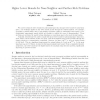Free Online Productivity Tools
i2Speak
i2Symbol
i2OCR
iTex2Img
iWeb2Print
iWeb2Shot
i2Type
iPdf2Split
iPdf2Merge
i2Bopomofo
i2Arabic
i2Style
i2Image
i2PDF
iLatex2Rtf
Sci2ools
FOCS
2006
IEEE
2006
IEEE
Higher Lower Bounds for Near-Neighbor and Further Rich Problems
We convert cell-probe lower bounds for polynomial space into stronger lower bounds for near-linear space. Our technique applies to any lower bound proved through the richness method. For example, it applies to partial match, and to near-neighbor problems, either for randomized exact search, or for deterministic approximate search (which are thought to exhibit the curse of dimensionality). These problems are motivated by search in large databases, so near-linear space is the most relevant regime. Typically, richness has been used to imply Ω(d/ lg n) lower bounds for polynomial-space data structures, where d is the number of bits of a query. This is the highest lower bound provable through the classic reduction to communication complexity. However, for space n lgO(1) n, we now obtain bounds of Ω(d/ lg d). This is a significant improvement for natural values of d, such as lgO(1) n. In the most important case of d = Θ(lg n), we have the first superconstant lower bound. From a compl...
Cell-probe Lower Bounds | FOCS 2006 | Lower Bounds | Stronger Lower Bounds | Theoretical Computer Science |
| Added | 11 Jun 2010 |
| Updated | 11 Jun 2010 |
| Type | Conference |
| Year | 2006 |
| Where | FOCS |
| Authors | Mihai Patrascu, Mikkel Thorup |
Comments (0)

